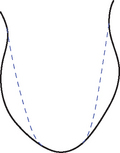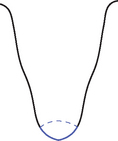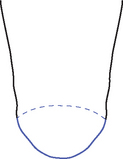Chapter 25 A Thin tongue is actually not common, probably because Dampness and Phlegm, which make the tongue Swollen, are such common and predominant pathogenic factors. As they tend to make the tongue Swollen, even if the patient has a concurrent severe Blood deficiency, this would not manifest on the tongue-body shape. In my practice, for example, out of 2378 patients, less than 2% have a Thin tongue while nearly 37% have a Swollen tongue. The size of the tongue body has to be related to the size of the head of the person: what might be “Swollen” for someone may be normal for another. (See Plate 25.1 on p. P23.) As the thickness of the tongue body depends on the supply of fluids and Blood, a Swollen tongue body indicates an accumulation of fluids, which may be Dampness, Phlegm or oedema. Thus a swelling of the tongue always indicates a Full condition and particularly one characterized by Dampness or Phlegm. Although Dampness and Phlegm usually arise from a Qi or a Yang deficiency, the swelling of the tongue body reflects the Full condition created by these two pathogenic factors. A swelling on the sides in the Liver area (Fig. 25.1) is very common and it usually indicates Liver-Heat; it is nearly always associated with a Red colour in the same area. A swelling on the sides in the chest/breast area (Fig. 25.2) generally indicates either retention of Phlegm in the chest or breast or Lung-Qi deficiency. A swelling of the tip of the tongue (Fig. 25.3), usually associated with a Red colour, is very common and it indicates Heart-Heat or Heart-Fire deriving from severe emotional problems. A swelling of the front third of the tongue (Fig. 25.4) indicates retention of Phlegm in the Lungs. (See Plate 25.2 on p. P23.)
 TONGUE-BODY SHAPE
TONGUE-BODY SHAPE
THIN
SWOLLEN
PARTIALLY SWOLLEN
![]()
Stay updated, free articles. Join our Telegram channel

Full access? Get Clinical Tree


Basicmedical Key
Fastest Basicmedical Insight Engine




